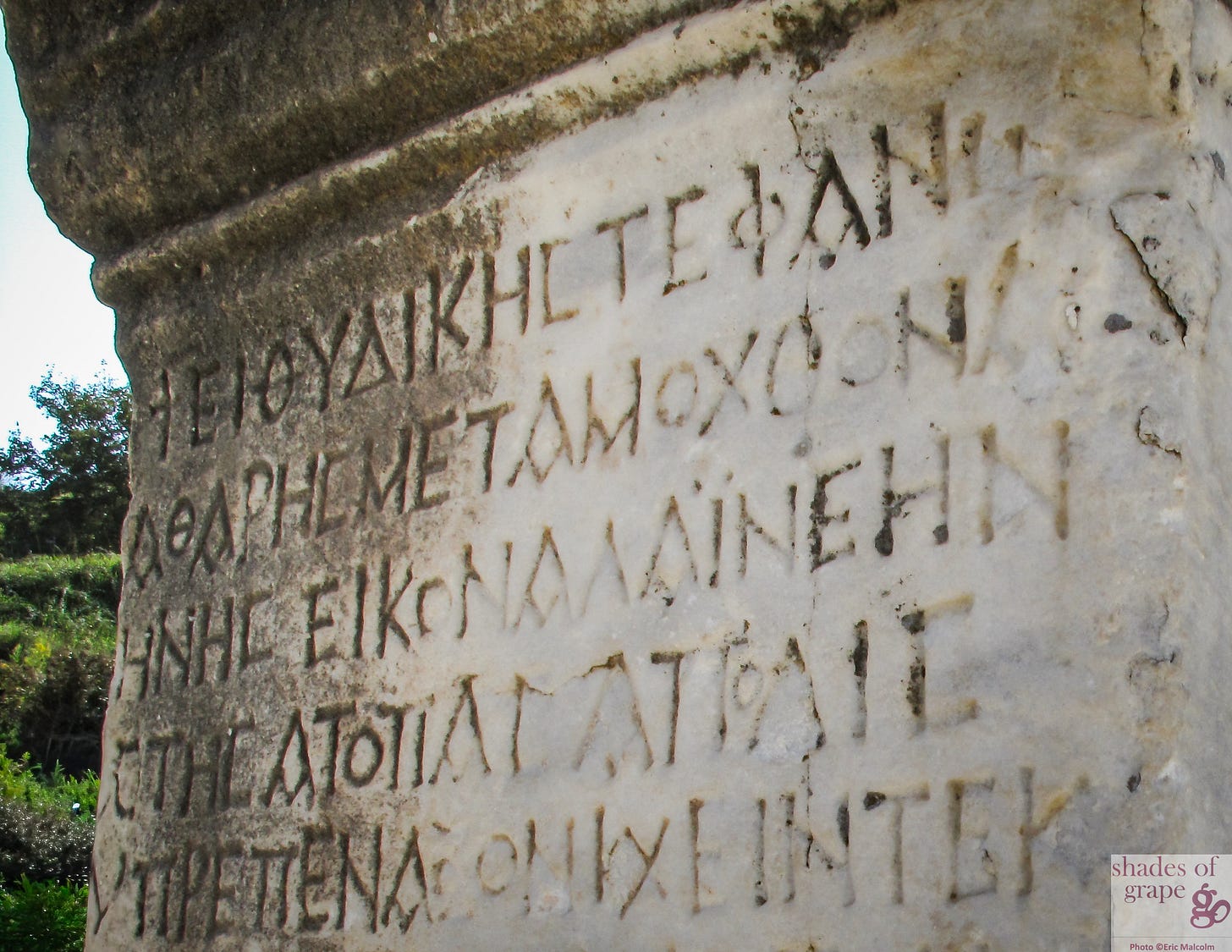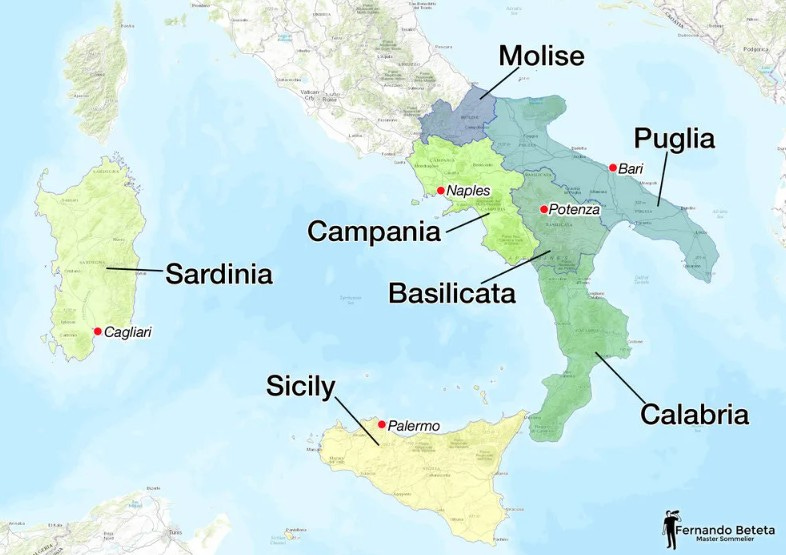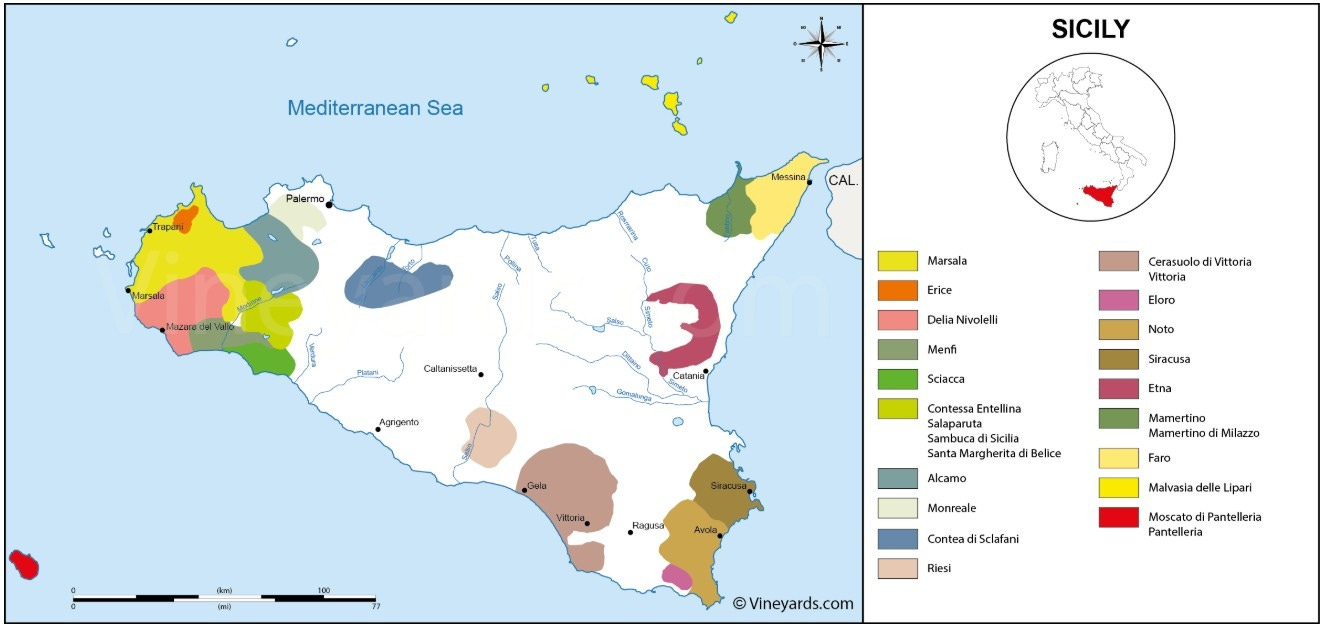Greece Gave Sicily Everything Wine; Sicily Gave Us Nero d’Avola
-wine etymology, vine dried grapes, quantity to quality, & more

Did you know that the grape name “Nero d’Avola” means “black (grape) of Avola”, Avola being the small town in southeast Sicily? This is where Nero d’Avola originates, specifically the province of Siracusa.
Sicily is the large island in southern Italy. It is like the soccer ball (or football) at the toe of the Italian peninsula. Sicilian wine production goes back to ancient Greece.
What, that’s crazy? When was that?
According to Encyclopedia Brittanica, ancient Greek civilization spanned from 1200 BC to 323 BC.
Blows me away.
Me too.
But even more impressive is that the earliest sign of human life was found there in the 13th millennium BC. It was in the 8th century BC that the Greeks kicked viticulture up a notch, although wild vines already grew there.
Wine has been a big part of Greek culture. To quote the book “The Mythology of Wine”, “For Greeks wine was an important marker of civilization; ignorance of it was a trait of savages…”
Strong words, but part of me believes this to be true!
Me too.
Reinforcing the importance of wine in Greek culture is that the word wine comes from the classical Greece word oinos. In “even older Greek” (whatever that is), the word was woinos. The first letter, called digamma, sounded like the English letter ‘w’ giving the word an even stronger similarity to the word wine.
Or winos, which is what I call myself.
Me too.
AND get this, there is more. The letter digamma was dropped from the Greek alphabet, which is how the word woinos came to be oinos.
Wow, what did digamma do to them? I wonder how that came to be.
Me too.
Like an ancient Greek expulsion.
Regardless, eventually oinos was transformed by the Etruscan and Latin to vinum followed by vino.
But let’s shoot forward to this era and Nero d’Avola.
By this era you mean AD?
Exactly. It was a botanist named Francesco Cupani (1657-1710) who first commented on the grape Nero d’Avola in 1696…
These dates blow me away always!
Me too!
Today, Nero d’Avola is the top black grape of Sicily, with the top white grape being Catarratto. The gang at Cork and I were all super impressed when we tasted the featured wine last week … such concentration and complexity. The concentration of flavors is a result of the way it was cultivated.
The grapes were dried on the vine for 15 days before harvest.
Huh? How does this work?
Before harvest time, the vine’s canes are cut or snapped from the main vine, while still remaining attached to the trellis. Without the vine’s water replenishment, the grape shrivels due to water evaporation. This leads to the reduction of juice volume, resulting in an increase in the concentration of its sugars, acids, aromas, and flavours.
Concentrated sugars, ugh, I am out – I don’t like sweet wines.
This is a dry wine as they fermented it to dry.
Meaning all the sugar was converted to alcohol? So it must be 17% alcohol. Still out.
Nope 13.5%!
Okay now, I am salivating.
Me too.
Quit agreeing with me. What is this, the #metoo movement?
Nope that is a different Substack.
How does this fit into your personal wine journey? Why is this wine relevant to you?
My initial reaction is that for once, this story doesn’t fit with my personal wine journey.
Huh, that doesn’t make for good content.
This is a part of the world I am exploring more. This is likely because like several southern Italian wine regions, Sicily focused on quantity over quality until recently. The grapes were allowed to grow to high yields and the winemaking was non-focused. It wasn’t until the 21st century, with EU wine support programs, that a shift started.
So ironically, even though Sicilian wine production started in the ancient times, modern Sicilian wine is in its infancy in wine terms.
Exactly.
Who would you recommend this wine to?
Someone who wants to experience unique aromas and flavours within a complex wine.
Unique is not necessarily endearing.
This wine has a brooding character, which is contradicted by the amazing perfume of rose, violet, incense, and exotic tea which created an almost lifting effect. This wine is lovely on its own and will pair great with food. Effortless to enjoy!
Right up my alley! Or should I say my vineyard row.
Oh boy, I cannot believe it has taken you this long to make that joke… check out more about the featured wine below.
Enjoying my recommendations? Consider upgrading to a paid subscription.
Prodigo Nero d’Avola 2023 from Sicily, Southern Italy
Style: Dry Old-World Medium Body Red Wine
Varieties: 100% Nero d’Avola
This wine is brooding yet ethereal and perfumed with rose, lilac, and lavender notes, with flavors of orange peel, crunchy red cherry, black currant, kirsch, sweet spice, incense, black tea, and nutty undertones. This wine has moderately high intensity, moderate, ripe, slightly grainy tannins, and a persistent finish.
Best pairings: Black tea-crusted lamb chops, Roast pork with fennel & orange zest, Moroccan lamb tagine with dried fruits and spice, Arancini, Wild mushroom pasta, Antipasti, Cheese: Aged goat cheese or smoked gouda.
Serving Temperature: 16-17 degrees Celsius
Serving Tips: Enjoy
Price: ~$27 Cdn
If you're in Alberta and want a one-on-one wine curation experience, please reach out! No commitment or minimum purchase required. Interested? Please reach out!
A huge thank you to my paid subscribers—your support helps cover the costs of creating these weekly articles.
Love my wine recommendations? Enjoy my personal wine curation service? If you find value in my writing, consider upgrading to a paid subscription to help me keep sharing the world of wine with you!
Subscribers receive 15% off Wine & Spirits whenever shopping at Cork Fine Wines, ground floor, Bow Valley Square in Calgary.
SOURCES:
George, A. (2020) The mythology of wine. https://openlibrary.org/books/OL32823454M/The_Mythology_of_Wine.
GmbH, W. (2017) Nero d’Avola. https://glossary.wein.plus/nero-d-avola.
Harding, J. and Robinson, J. (2023) The oxford companion to wine. Oxford, United Kingdom: Oxford University Press.
Hornblower and Simon (2025) Ancient Greek civilization | History, Map, Culture, Politics, Religion, Achievements, & Facts. https://www.britannica.com/place/ancient-Greece.
Kirk and S, G. (2025) Homer | Biography, Poems, & Facts. https://www.britannica.com/biography/Homer-Greek-poet.
MacNeil, K. (2022) The wine bible. New York, NY: Workman Publishing.
Prodigo Nero D’Avola - Winesellers, Ltd. (2025). https://www.winesellersltd.com/wine_asset/prodigo-nero-davola/?utm_source=chatgpt.com.
Sicily map of vineyards wine regions (no date). https://vineyards.com/wine-map/italy/sicily.
SRL, C. (2021) THE SICILY - SiciliaDoc. https://siciliadoc.wine/en/the-sicily/.
Stacy.Louise and Stacy.Louise (2020) 'Wine region Overview: Southern Italy - Briscoe bites,' Briscoe Bites - Booze, Baking, Big Bites and More!, 21 August. http://briscoebites.com/wine-region-overview-southern-italy/.
Wine & Spirit Education Trust (2021) D3: Wines of the World - An accompaniment to the WSET Level 4 Diploma in Wines. Version 1.2. London: Wine & Spirit Education Trust.





Love etymology + wine
Never - thank goodness! You have plenty to teach us.